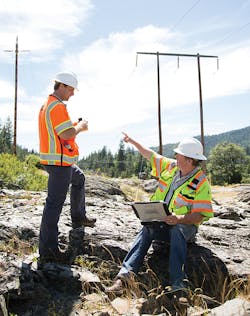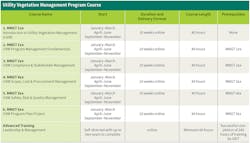Over the last several decades, utility vegetation management (UVM) programs have evolved into multifaceted maintenance programs. The UVM industry has long recognized many of the seasoned industry experts who helped to develop today’s modern and sophisticated programs are now retired or preparing to retire. This turnover at the program leader level, combined with greater complexity in developing and delivering today’s integrated programs, has created some urgency in filling the knowledge, skills and attitudes gap.
Contractors, consultants and utility employees who play vital roles in delivering innovative and integrated programs in a sustainable way now have access to a new UVM professional development training program. The new UVM training touches on most of the subjects and issues a 25-year seasoned professional would be exposed to throughout a career.
UVM Training Program
Today, an abundance of information is available on general UVM programs and topics in articles, books, research papers and individual utility documentation. Unfortunately for those wanting to accelerate their knowledge about the broader scope of the UVM industry, there was no single place to go to learn about it. In fact, some of the most valuable industry intelligence remains in the heads of those who spent years networking and learning, and who are now retiring or changing jobs. Further, key stakeholder groups such as consultants and contractors are constantly looking for ways to advance their employees from within and reduce turnover rates. These factors heighten the need to continuously improve training opportunities within the industry.
Fortunately, the industry’s lack of a central source of comprehensive UVM training material may now be a thing of the past. Various courses, certifications and educational opportunities are available in-house or through short courses offered online. Organizations such as the Centre for Energy Advancement through Technological Innovation (CEATI), Electrical Industry Training Institute Global (EITI), Olds College, Southern Alberta Institute of Technology (SAIT) and others have started or are in the process of offering programs to address some of the learning needs.
An excellent example is the new UVM business-focused training curriculum developed by the Utility Arborist Association (UAA) and Utility Vegetation Management Association (UVMA). The UVM training is a two-year online program designed to accommodate working professionals. It covers the entire scope of topics a seasoned worker should know to be an effective UVM supervisor or manager.
No other training today covers the entire scope of a modern UVM program in this highly flexible and manageable way. The program includes operational aspects of the UVM industry as well as a significant management and leadership component. Contractor, consultant and utility employees get in-depth insight into each other’s roles in the industry. By providing UVM training at the college level, people are encouraged to stay engaged in the right-of-way management business.
SAIT’s School of Business was chosen as the education delivery partner for the foundational UVM program portion because of the school’s long history of delivering high-quality education on campus and online. Desire to Learn (D2L) is the learning management system used to present the curriculum to students around the world. SAIT launched the pilot UVM training in May 2016, coinciding with the school’s 100th anniversary. The additional business management related training will be available from a variety of self-directed online sources.
Key Components
The program includes a total of 300 hours of online training. The foundational UVM program delivered by SAIT consists of six 40-hour courses, for a total of 240 hours of training. These six courses focus heavily on operations and contain a brief introduction to business, safety culture and leadership concepts. The six SAIT courses can be completed within a two-year period; however, if necessary, students have up to a five-year period to complete all the courses. The additional 60 hours of training includes advanced business management related training, which can be obtained from a variety of self-directed sources.
The following is an example of the topics within the two key components:
- The academic portion delivered through the SAIT program (which requires 240 hours) includes the following topics: an introduction to UVM; understanding utility systems; regulatory compliance; stakeholder interactions; utility arboriculture; impact of species and growth; integrated UVM; optimization of crew and equipment resources; managing risk; data collection and management systems; contract options and design; project management; UVM and integrated vegetation management best management practices; and program planning.
- The additional advanced courses (minimum 60 hours) delivered by a variety of online self-directed training opportunities may include topics such as business case management, a culture of safety, leadership and any other approved management-related courses chosen by the student to advance their professionalism.
The program is based on adult learning theory and principles that reinforce learners who need to know the reason for learning; are self-directed and like to be part of decision making; have a wealth of lifelong learning experiences to share; take a problem-centered approach to learning solutions to real-life issues within their daily lives; are internally motivated and learn best in an open and safe learning environment.
Industry subject-matter experts facilitate the student learning process and act as guides by issuing instructions on what is expected. All assignments are graded using a rubric, which students have access to in advance so they can see what they must do to be successful. There are no final exams, rather students are assessed and graded as they progress through the course activities and assignments.
The UVM courses focus on the transfer of learning to the workplace and provide the opportunity to reflect critically on module topics, concepts and processes through learning journal entries. It is important to note the UVM courses are structured to enable students to apply what they learn to their current job and region. The courses require interaction with many stakeholders, which will result in strengthening the student’s knowledge, network and relationships.
Expected Beneficiaries
The utility industry as well as public, consultant and contractor stakeholders benefit from this program. Comprehensive UVM training benefits utilities because it provides a variety of topics and content that may go beyond the exposure offered to employees through in-house training. Many utilities — including public, shareholder owned and cooperatives — do not have the in-house capacity to develop and deliver comprehensive UVM training. Small and large utility organizations now have an advanced level of education available through the UVM program.
Consultants and contractors rarely can examine the full range of issues from the standpoints of regulators and the public. Students in the UVM program benefit from experiencing the challenges and impediments associated with delivering an approved UVM program from the viewpoint of each stakeholder.
Industry Remarks
The UVM industry has evolved significantly over the past few decades. It continues to evolve as regulatory and public demands increase. New generations are entering the industry as utility employees, contractors and consultants. At the same time, industry program leaders are heading off to a well-deserved retirement. There is a need to accelerate the knowledge transfer to ensure the industry stays ahead of the curve. Training like the UVM program and other comprehensive, professionally prepared and delivered UVM courses will help during this time of transition.
Derek Vannice, president of CN Utility Consulting, provided the following feedback on the UVM program: “This program has been needed for the utility vegetation management industry for a long time. There has never been a professionally developed, industry-reviewed training curriculum for utility vegetation managers. We are very excited about this new program. We have one of our employees going through the program currently, and he has already found a great deal of value in what he has learned. This program will raise the professional standard for utility vegetation managers.”
Phil Charlton, executive director of UAA, also commented: “The UAA is excited about the UVM training program and pleased to support this initiative. It was conceived and developed by industry professionals who engaged education professionals to ensure success. The quality of the results is easy to see. The UVM provides, for the first time, a means of training managers and making available the experience and knowledge of generations of industry leaders and managers who had to learn by trial and error. It’s a great innovation that will continue the industry’s drive toward excellence with better-educated managers bringing greater value to their employers, the UVM industry and the public.”
Many seasoned UVM managers say they are excited and encouraged that a group of younger employees is willing to learn and prepare to take over UVM industry leadership. Many of them see professional development training as an important part of filling the knowledge gap for the younger or transitioning employees who are new to the UVM industry. ♦
Neil Thiessen has been involved in the UVM business as a contractor, utility program manager and small business consultant for more than four decades. Thiessen is past president of the Utility Arborist Association, Utility Vegetation Management Association and Professional Vegetation Managers Association, and he serves as executive director of several industry organizations.
Nelsen Money spent 35 years in various UVM roles at Pacific Gas and Electric Co. He is a past president of the Utility Arborist Association and currently a lead auditor for the Right-of-Way Stewardship Council accreditation program.
Sidebar: UVM Program Fills Need for Professional Training
Alan Lucas, manager of right-of-way management and field analysis at AltaLink, says there is a real need for professional training and believes in the utility vegetation management (UVM) program.
“Over the years, AltaLink has seen an increased need for attention to detail in the development and delivery of our UVM program,” Lucas said. “We credit our success in meeting industry standards and becoming accredited by the Right-of-Way Stewardship Council to the planning and hard work of staff and stakeholders. However, as public and regulatory demands increase, so does the need for more knowledgeable and skilled professionals.
“Many utilities are experiencing retirements and competition for experienced professionals, which is impacting our ability to replace and retain the quality employees we require. To solve this issue, AltaLink is participating in the new UVM training program. This industry-developed training program is designed specifically to bridge the knowledge gap common in less-experienced workers and address continuing demands for excellence. An AltaLink employee currently enrolled in the program often mentions it is helping him gain knowledge about the industry, which he applies to his job each day.
“AltaLink is looking at options to make this training part of future agreements with contractors to ensure there is alignment when contract employees are working with AltaLink staff, thereby increasing our joint ability to innovate and implement continuous improvement,” Lucas said.
As a student participating in the UVM program, Adam Warf, a business development and project manager at Environmental Consultants Inc., is grateful for his firsthand experience.
“The UVM program provided me with a deeper look into our industry’s key stakeholders, both internal and external, and assisted me in developing the best management techniques for dealing with issues pertaining to these stakeholders,” Warf said. “Program participants are provided with an extensive array of course material, including videos, research papers and educational internet resources. In addition, the involvement of course participants from all parts of North America leads to tremendously diverse conversations and opportunities for learning in the class discussion forums.”
Sidebar: Critical Reflection — Budget Analysis
Keep in mind that part of being a manager or leader is to question the reasons why we do the things we do and to determine if there are ways to do things more effectively or efficiently going forward.
Reminder:
Please reference in your journal any resources (existing manuals, persons, etc.) consulted during this critical reflection research.
Tasks:
- Obtain a copy of your organization’s master budget and your utility vegetation management (UVM) program budget.
- Obtain a copy of your organization’s mission, vision and values. (Strategic Plan)
- Prepare a diagram map of all the master budget components. (Refer to Module 5 Budget Hierarchy)
- Prepare a diagram map of all the UVM program budget components. (Refer to Module 5 Budget Hierarchy)
- Critically reflect on the budgets: Where does the UVM budget fit into the master budget? Who is responsible? Who has signing authorities? What are the limits? How is the budget created, tracked and monitored? Do the budgets align with the mission, vision and values of the organization? If not, why not? What are the individual line items? What items go under these line items? How do you come up with the totals for the line items? What influence do you have on the budget? What factors impact the budget?
Note: You may need to discuss some of these items with your supervisors or managers, management and financial personnel. (Should you not have the support of your supervisors, the UVMA has enlisted the assistance of industry mentors who can assist you with your learning journey.)




